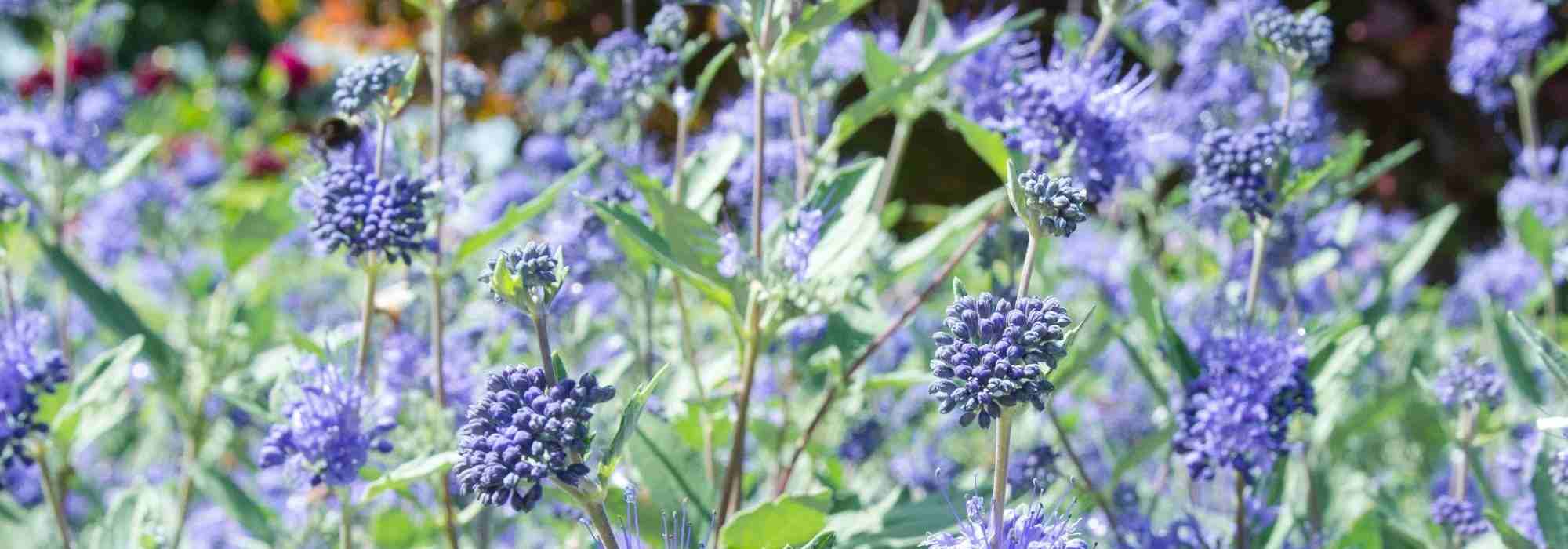
7 ideas for pairing Caryoptéris
Discover our ideas and inspiration
Contents
Caryopteris, also called Bluebeard or blue spirea, is a deciduous undershrub appreciated for its natural rounded habit and the colour of its leaves and flowers. Indeed, depending on variety, Bluebeard can have different foliage: silver‑green, golden, variegated with creamy white for Caryopteris x clandonensis ‘White Surprise’ or golden‑yellow for the Caryopteris x clandonensis ‘Summer Sorbet’. Its flowers in spikes are generally pale blue with violet shades and appear from August to October, but there are new varieties with a more intense blue such as Caryopteris ‘Grand Bleu’ and ‘First Choice’. Moreover, although flowers are not scented, leaves provide pleasing fragrance.
Blue spirea fits into many outdoor scenes: English garden, scented garden, blue‑and‑yellow garden, dry garden, romantic garden, in a hedge of bushes or in a pot. To enjoy a flower‑filled late summer, why not add it to your garden! Discover our ideas for pairing with your Caryopteris.
In an English-style garden
Caryopteris ‘Heavenly Blue’ is very well suited to an English garden. Its violet-blue will be enhanced when paired with perennial plants and bushes of varied colours and forms. To give the border movement, plant Miscanthus or flowering bushes at the back, such as flowering currant, mock orange and a Van Houtte spirea.
Then, compose your border with perennial plants planted in drifts to create attractive blocks of colour. Sedum ‘Matrona’ brings softness with its pastel-pink flowers; then add some white Agapanthus ‘Graphite White’ for a touch of brightness. These are hardy to -15°C, but you can replace them with white roses, such as shrub rose ‘Escimo’, if you are in a region with severe winters.
In warm tones, the Rudbeckia fulgida ‘Goldsturm’ and Echinacea ‘Orange Skipper’, with yellow and orange flowers, bring cheer to the border. Finally, Knautia macedonica ‘Red Knight’ enlivens the whole with its deep crimson. The aim is to have a very decorative border with a natural look.
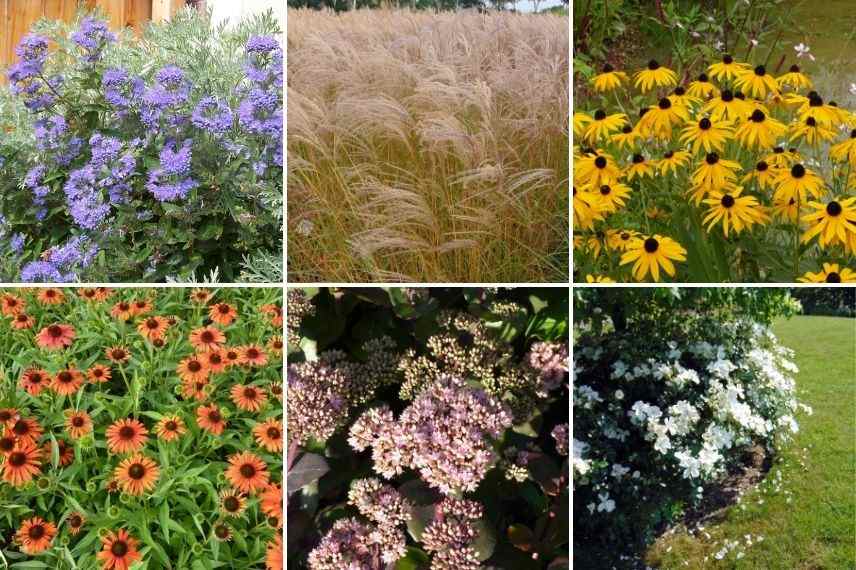
Caryopteris x clandonensis ‘Heavenly Blue’ (Photo Wikimedia), Miscanthus sinensis ‘Flamingo’, Rudbeckia fuldiga ‘Goldsturm’, Echinacea ‘Orange Skipper’ (Photo Guido), Sedum ‘Matrona’ and shrub rose ‘Escimo’
Read also
10 evergreen bushes for dry soilIn a scented garden
Caryopteris has scented leaves when crushed, so this bush is well suited to use in a scented garden. To achieve this, plant your plants so they can be touched and smelled. Avoid planting them too far back and always plant larger specimens first at the rear. For a scented garden, we recommend Caryopteris ‘Hint of Gold’ with its aniseed-lavender scent, forming a regular ball about one metre across. It can be integrated into a scene with other scented bushes: in front of an Chimonanthus praecox flowering from November to February and a lilac flowering in spring.
Then, slot in some scented roses, such as English rose ‘Brother Cadfael’ flowering from June to October with a very pronounced fragrance. At their feet, add some fragrant perennials: Artemisia ludoviciana ‘Silver Queen’ with its attractive grey foliage, Pelargonium odorant ‘Lemon Fancy’ with its pale pink flowers, Agastache, Monarda, peony. In smaller proportions, plant ornithogales or hyacinths in the foreground. This way, flowering follows throughout the year.
You can also combine Caryopteris with edible aromatic plants: thyme, mint, basil, oregano, rosemary, lemon balm, marjoram and many others.
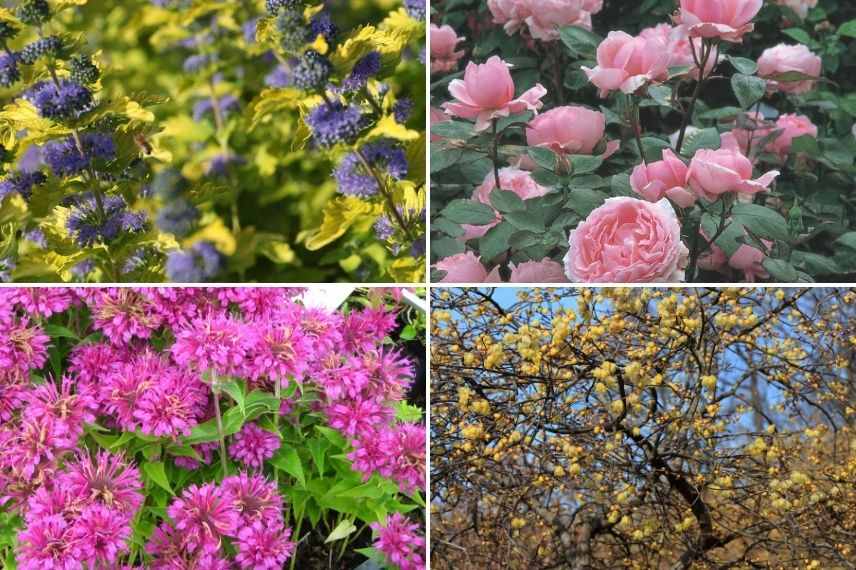
Caryopteris ‘Hint of Gold’, Rose ‘Brother Cadfael’, Monarda ‘Purple Lace’ and Chimonanthus, which will flower early in late winter
Discover other Caryopteris
View all →Available in 2 sizes
Available in 0 sizes
Available in 1 sizes
Available in 1 sizes
Available in 1 sizes
Available in 1 sizes
Available in 3 sizes
Available in 1 sizes
Available in 3 sizes
Available in 1 sizes
In a blue and yellow garden
For a garden full of originality and contrast, dress your garden in blue and yellow. To achieve this, opt for Caryopteris ‘Worcester Gold’ with golden foliage and lavender-blue flowers. As a backdrop, choose larger bushes, such as Spiraea japonica ‘Goldflame’ with seasonally changing foliage, or larger still, Choisya ternata ‘Sundance’ with yellow leaves and fragrant flowers.
Ornamental grasses can also join in: Pennisetum ‘Hameln’ offers a fine flowering of golden bottlebrush plumes from September to October, while Festuca ‘Elijah Blue’ forms a low clump of steel-blue foliage.
Combine your Caryopteris with gold-coloured perennials such as Heliopsis ‘Mars’, Coreopsis ‘Full Madness’ and Hemerocallis ‘Stella De Oro’. To accompany it in cool tones, add blue plants: aromatic, compact Nepeta ‘Purrsian Blue’, Aster novi-belgii ‘Audrey’ with autumn flowering and groundcover Ceratostigma plumbaginoides.
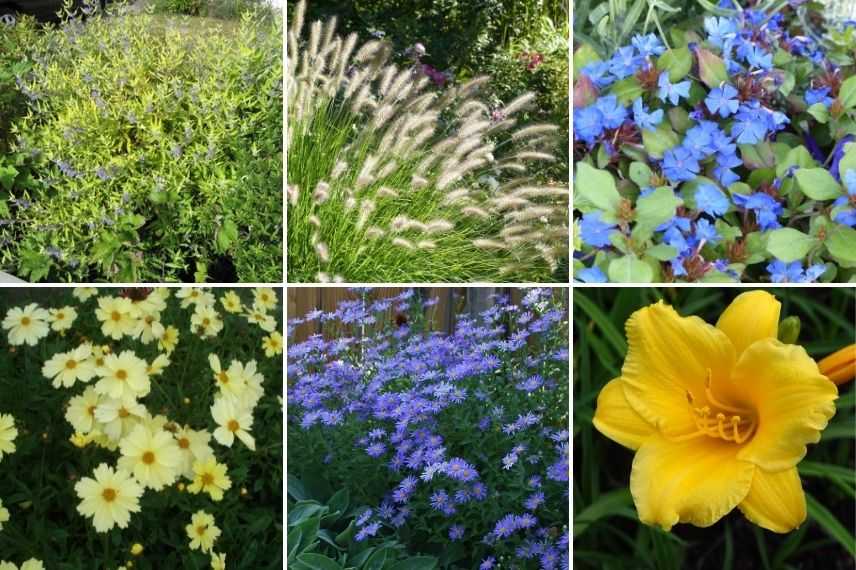
Caryopteris ‘Worcester Gold’ (Photo Wallygrom), Pennisetum ‘Hameln’, Cerastostigma plumbaginoides, Coreopsis ‘Full Madness’, Aster ‘Audrey’ (Photo P. Standish) and Hemerocallis ‘Stella de Oro’
In a romantic garden
Caryoptéris ‘Pink Perfection’ is one of the few varieties to have pink flowers. This pretty delicate colour makes it the ideal candidate for a romantic garden. To emphasise verticality, introduce white hollyhocks such as the robust variety ‘Chater’s Double Blanc’ with large pompon-like flowers that can reach two metres in height. For your display, consider roses in pastel shades such as the bush roses ‘Bonica’ with perpetual light-pink flowering and ‘Dioressence’ with large scented mauve flowers. Also favour plants with grey foliage, such as the bush Perovskia atriplicifolia ‘Blue Steel’ or, for a smaller option, the perennial Artemisia ludoviciana ‘Silver Queen’. Finally, in the foreground, plant the perennial Cerastium tomentosum ‘Columnae’ or ‘Yo Yo’ offering a profusion of white flowers.
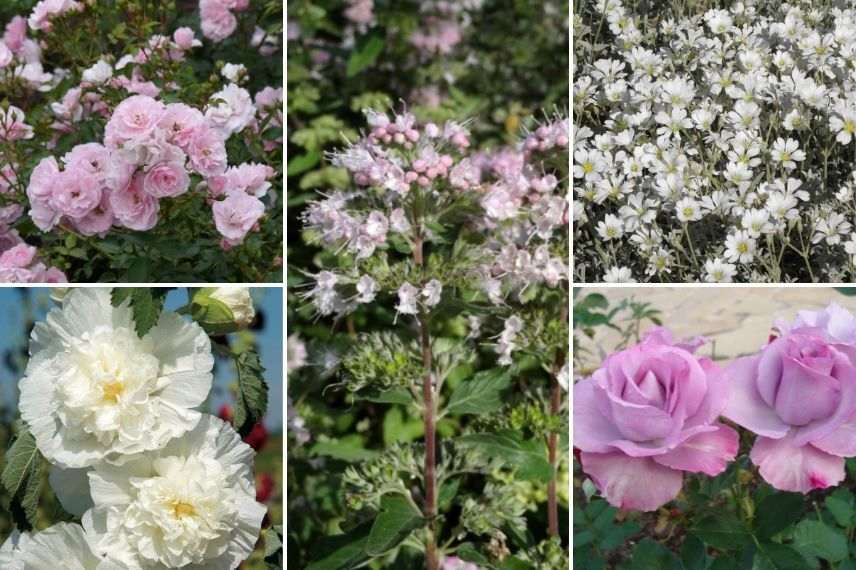
Rose ‘Bonica’, Caryoptéris ‘Pink Perfection’ at centre, Cerastium ‘Yo Yo’, hollyhocks ‘Chater’s Double Blanc’ and rose ‘Dioressence’.
In a dry garden
Caryopteris, being sun-loving and drought-tolerant, can be grown in a dry garden. Plant succulents that withstand heat well. Silver leaves of Caryopteris x clandonensis ‘Sterling silver’ will be set off by deep red of Sedums ‘Autumn Joy’. Kniphofia ‘Little Maid’ adds brightness to garden with its yellow flowers borne on spikes and its habit will lighten border. Ornamental grasses are also welcome in dry gardens. Stipa pennata is ideal: it likes poor soil and sun. It is prized for its silver spikes that float delicately in wind.
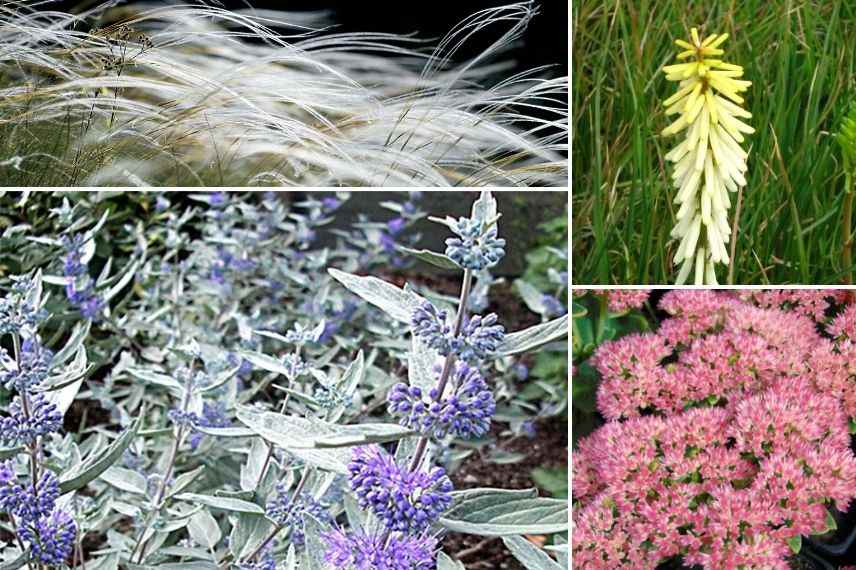
Stipa pennata, Kniphofia ‘Little Maid’, Caryopteris ‘Sterling silver’ and Sedum ‘Autumn Joy’.
In a low hedge
To create a low hedge of bushes, we recommend the Caryoptéris ‘Grand bleu’ reaching one metre in height with a 1.5 metre spread. For a successful hedge, choose bushes of roughly similar height whose flowering is staggered throughout the year. The Daphné ‘Perfume Princess’ flowers early in the year. Large clusters of scented pink flowers appear from January to April. Next, for flowering from April to May, Viburnum burkwoodii ‘Conoy’ takes over. It is also valued for its pleasant scent reminiscent of orange blossom. Clerodendrum bungei ‘Pink Diamond’, with pink flowers, reaches 1.20 metres in height at full size and flowers from August to October. Finally, the Buddleia ‘Free Petite Lavender Flow’ produces mauve-lavender flowers from May to November. It forms a compact, rounded habit, reaching one metre in height at ripeness.

Clérodendron ‘Pink Diamond’, Caryoptéris ‘Grand Bleu’ and Daphné ‘Perfume Princess’
In large pot or planter
Bluebeard can be planted as a duo in a large, wide round pot. Pairing Caryopteris ‘Heavenly Blue’ and Rose ‘Joie de Vivre’ works very well. Indeed, the pastel pink flowers with apricot tones of this dwarf rose combine well with the violet-blue of the shrub.
Another option is to plant it in a large trough or urn. Take the Caryopteris ‘Petit bleu’, add a Herb aux écus ‘Goldilocks’ with a trailing habit, dwarf Dahlias ‘Claudette’ in violet and ‘Gallery Valentin’ in warm orange, a Carex comans ‘Milk Chocolate’ with bronze highlights or a Pennisetum ‘Little Bunny’ with numerous beige bottlebrushes and you will obtain a magnificent colourful composition!
In a large, deep planter, plant Caryopteris clandonensis ‘Stephi’ alongside thyme and sage.
When planted in pots or troughs, we recommend allowing soil to dry out between waterings. Indeed, Caryopteris does not tolerate stagnant moisture. In winter, place pot close to a wall to protect from wind, mulch its base with dead leaves and cover with horticultural fleece if it is not possible to bring the pot indoors.

Caryopteris ‘Petit Bleu’, Herb aux écus ‘Goldilocks’, Dahlia ‘Claudette’ and ‘Gallery Valentin’ and Carex ‘Milk Chocolate’
To go further
If you would like more advice to grow Caryoptéris, see our family sheet Caryoptéris, Blue Spirea: planting, pruning, maintaining
- Subscribe!
- Contents
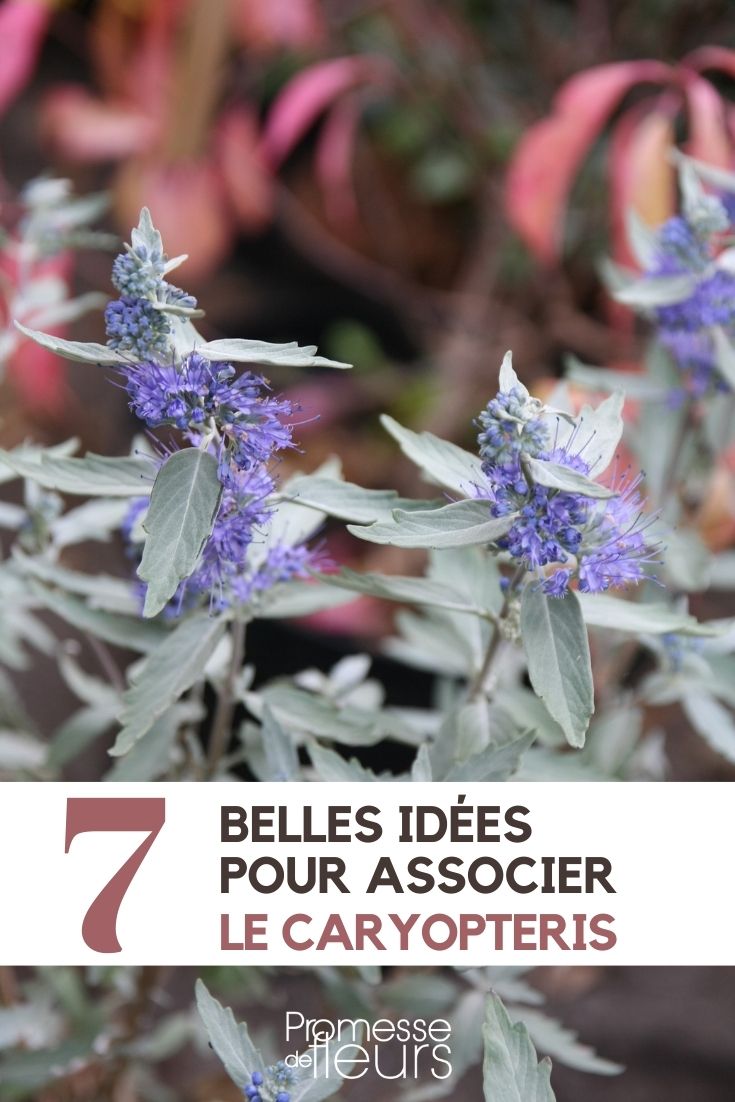































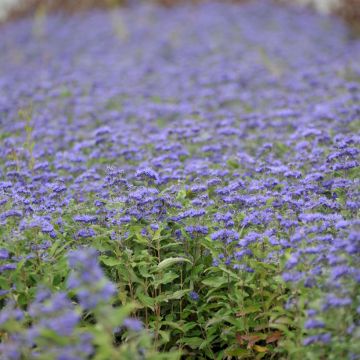
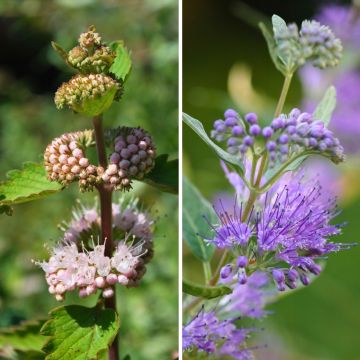
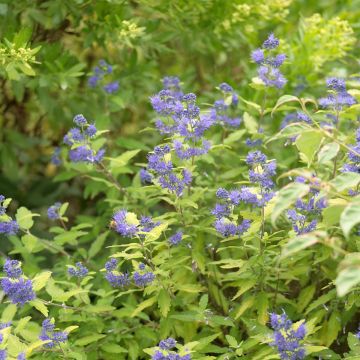
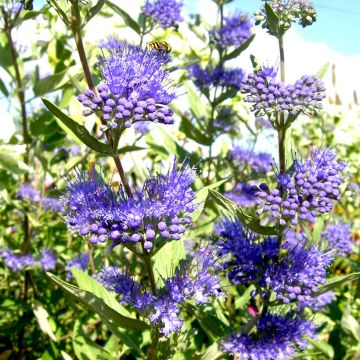
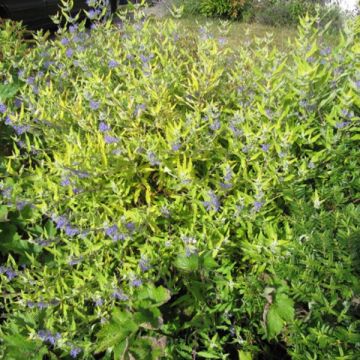
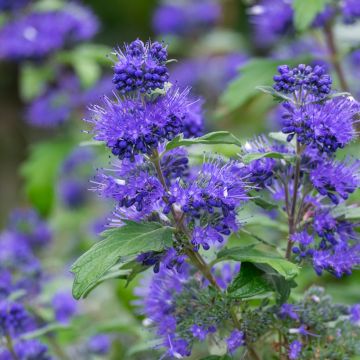
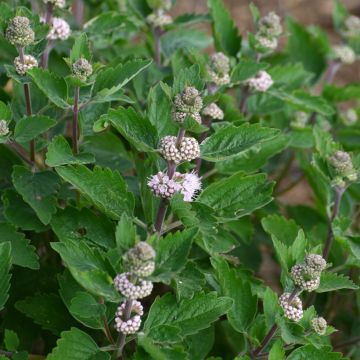
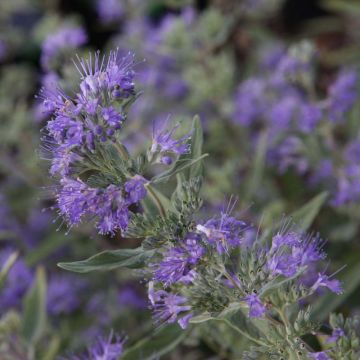
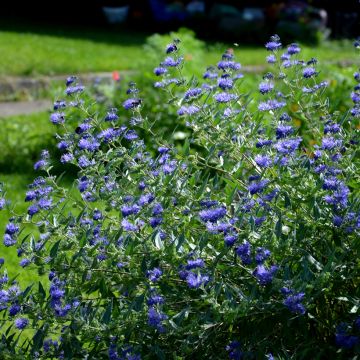
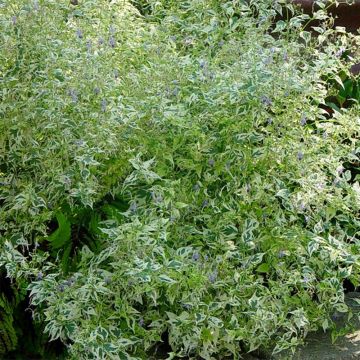
Comments